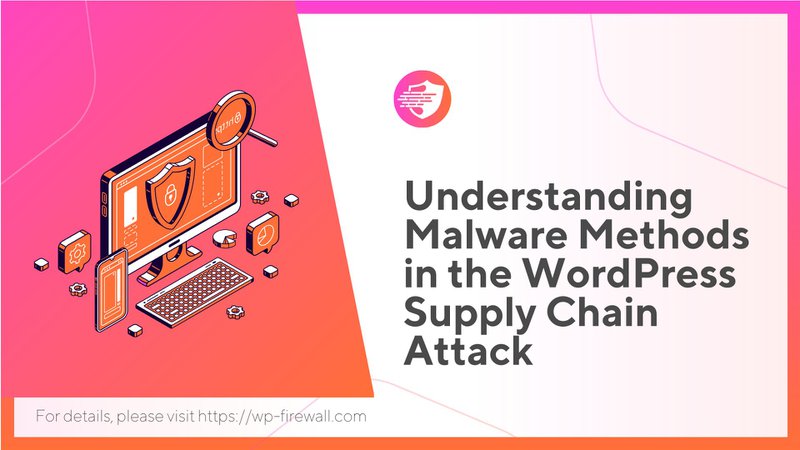
The recent supply chain attack on WordPress.org has sent ripples through the digital security community, highlighting critical vulnerabilities that demand our attention. This blog delves into the intricacies of this attack, examining the malware and techniques employed by the perpetrators, and provides actionable insights on how to fortify your WordPress environment against such sophisticated threats.
1. A Detailed Overview of the Supply Chain Attack
The WordPress.org supply chain attack is a stark reminder of the evolving nature of cybersecurity threats. In this incident, attackers targeted the WordPress.org infrastructure, injecting malicious code into plugins and themes distributed through the official repository. This malicious code, once installed on a user’s site, allowed attackers to gain unauthorized access, steal sensitive information, and potentially disrupt site operations.
The complexity of this attack lies in its subtlety and sophistication. The attackers not only targeted widely-used plugins and themes but also ensured that the malicious code remained hidden for extended periods. This delayed detection gave them ample time to exploit the compromised sites fully. The attackers' ability to blend into legitimate traffic and activities made traditional detection methods less effective, underscoring the need for more advanced and proactive security measures.
2. Key Themes and Insights Relevant to WordPress Security
2.1. Supply Chain Vulnerabilities in WordPress
Supply chain attacks exploit the trust relationships between software providers and their users. In the WordPress ecosystem, plugins and themes are essential components that can become vectors for malicious code if not properly vetted. The attack on WordPress.org underscores the importance of rigorous security checks and the implementation of strict protocols to verify the integrity of all distributed software.
The WordPress ecosystem is vast, with thousands of plugins and themes available for users. This diversity, while beneficial, also presents a significant challenge for security. Ensuring that every piece of code is free from vulnerabilities requires continuous effort from both developers and users. Developers must adopt secure coding practices and regular security audits, while users should be cautious about the sources of their plugins and themes and keep them updated.
2.2. Specific Malware Types and Their Functionalities
The attackers used a range of malware types, each with distinct functionalities designed to exploit different aspects of the WordPress environment. These included backdoors for persistent access, data exfiltration tools for stealing information, and malware designed to manipulate site content or functionality. Understanding these malware types helps in identifying and mitigating potential threats before they can cause significant damage.
For instance, backdoors allow attackers to maintain access to compromised sites even after initial vulnerabilities have been patched. These backdoors are often embedded in the code in a way that is difficult to detect. Data exfiltration tools focus on stealing sensitive information such as user data, financial details, and proprietary content. Such information can be sold on the dark web or used for further attacks. Manipulative malware can alter site content, redirect traffic, or create spam posts, damaging the site's reputation and SEO rankings.
2.3. Techniques Used by Attackers to Infiltrate and Compromise WordPress Environments
The techniques employed in this attack were highly sophisticated. Attackers used obfuscation to hide malicious code, making it difficult for traditional security tools to detect. They also employed social engineering tactics to trick users into downloading compromised plugins and themes. Additionally, leveraging zero-day vulnerabilities allowed attackers to bypass security defenses and gain control over targeted sites.
Obfuscation techniques often involve encrypting or disguising code to prevent detection. This can include altering variable names, embedding malicious code within legitimate code, and using encryption to hide the payload. Social engineering exploits human psychology, convincing users to take actions that compromise security, such as downloading a seemingly legitimate but infected plugin. Zero-day vulnerabilities are particularly dangerous because they exploit unknown flaws in software, giving attackers a head start before the vulnerabilities are patched.
2.4. Impact and Implications of the Attack on WordPress Users
The implications of the WordPress.org supply chain attack are far-reaching. For individual site owners, this means potential data breaches, loss of customer trust, and financial repercussions. For the broader WordPress community, it highlights the need for enhanced security measures and greater awareness of the risks associated with third-party software.
A successful supply chain attack can have a cascading effect. Once a popular plugin or theme is compromised, thousands of sites can be infected within a short period. This not only affects individual site owners but also erodes trust in the WordPress ecosystem as a whole. Recovering from such an attack involves not only technical fixes but also rebuilding user trust and addressing potential legal and financial consequences.
2.5. Measures for Detecting and Mitigating Such Attacks
To detect and mitigate supply chain attacks, it is crucial to implement comprehensive security measures. Regularly updating plugins and themes, conducting security audits, and using advanced malware detection tools are essential steps. Additionally, maintaining a robust backup strategy ensures that you can quickly recover in the event of a security breach.
Advanced malware detection tools leverage artificial intelligence and machine learning to identify unusual patterns and behaviors that may indicate a security threat. Regular security audits help identify vulnerabilities before attackers can exploit them. A robust backup strategy is your last line of defense, ensuring that you can restore your site to a pre-attack state without significant data loss.
3. WP Firewall’s Comprehensive Security Solutions
At WP Firewall, we are dedicated to providing cutting-edge security solutions to protect your WordPress environment. Our suite of tools includes advanced malware detection, real-time threat monitoring, and automated vulnerability assessments. By leveraging the latest in security technology, we help you stay ahead of potential threats and ensure the integrity of your site.
3.1 Expert Analysis and Recommendations for Enhanced Security
Our team of security experts continuously analyzes emerging threats and develops strategies to counteract them. By following our expert-driven insights and proven security measures, you can fortify your WordPress installations against even the most advanced attacks.
For instance, our experts recommend regular updates and patch management as critical steps. Keeping your WordPress core, themes, and plugins up to date reduces the risk of exploitation through known vulnerabilities. Additionally, implementing multi-factor authentication (MFA) adds an extra layer of security, making it more difficult for attackers to gain access.
3.2 Innovative Technologies for Preventing Supply Chain Attacks
WP Firewall employs innovative technologies such as machine learning algorithms and behavior analysis to detect and prevent supply chain attacks. These tools not only identify known threats but also predict and mitigate new ones, providing a proactive defense for your WordPress site.
Machine learning algorithms analyze vast amounts of data to identify patterns that may indicate malicious activity. Behavior analysis focuses on monitoring the actions within your WordPress environment, flagging any deviations from normal behavior that could suggest a compromise. These technologies work together to provide a multi-layered defense strategy.
3.3 User-Friendly and Accessible Security Solutions
We understand that not all users are cybersecurity experts. That’s why our tools are designed to be user-friendly and accessible, offering simplified explanations of complex security concepts and step-by-step guides for implementing security measures.
Our user interface is intuitive, providing clear instructions and visual aids to help you navigate the security features. Whether you are setting up a new security plugin or running a vulnerability scan, our guides ensure that you can do so with confidence, regardless of your technical expertise.
3.4 Proactive Monitoring and Threat Detection
Our proactive monitoring systems ensure that threats are detected before they can cause harm. By continuously scanning your site for vulnerabilities and suspicious activities, we help you maintain a secure environment at all times.
Proactive monitoring involves real-time analysis of traffic, user behavior, and system logs. Any anomalies are immediately flagged and investigated, allowing for swift action to mitigate potential threats. This proactive approach reduces the window of opportunity for attackers, minimizing the risk of successful exploitation.
3.5 Comprehensive and Robust Security Strategies
WP Firewall’s comprehensive security suite offers all-encompassing protection for your WordPress site. From basic security checks to advanced threat mitigation strategies, we provide the tools and support you need to safeguard your digital presence.
Our security strategies include regular security training for users, ensuring that everyone involved in managing your WordPress site understands the best practices for maintaining security. We also offer incident response services, providing expert assistance in the event of a security breach to quickly restore normal operations and minimize damage.
4. Case Studies and Success Stories
To illustrate the effectiveness of our security solutions, consider the case of a popular e-commerce site that experienced repeated attacks due to vulnerabilities in third-party plugins. After implementing WP Firewall’s comprehensive security suite, the site saw a significant reduction in security incidents. Our advanced detection tools identified and neutralized threats before they could cause harm, while our regular security audits and updates ensured that the site remained secure.
Another success story involves a large educational institution that was targeted by a sophisticated phishing attack. Using our proactive monitoring and behavior analysis tools, we detected the attack in its early stages and implemented measures to block it. The institution’s IT team received detailed reports and recommendations on how to prevent similar attacks in the future, enhancing their overall security posture.
5. Stay Informed with WP Firewall
The WordPress.org supply chain attack is a clear reminder of the ever-present cybersecurity threats facing website owners. By staying informed and implementing robust security measures, you can protect your site from similar attacks. Sign up for our newsletter to receive the latest security news, expert tips, and updates on WP Firewall’s innovative solutions. Together, we can build a more secure WordPress ecosystem.
Conclusion
In the face of evolving cybersecurity threats, it is essential to stay vigilant and proactive. The WordPress.org supply chain attack serves as a critical lesson for all website owners and developers. By understanding the nature of these attacks and implementing comprehensive security measures, you can safeguard your digital assets and maintain the trust of your users. WP Firewall is here to support you every step of the way with cutting-edge tools, expert insights, and a commitment to your security. Sign up for our newsletter today and take the first step towards a more secure WordPress environment.

